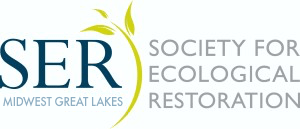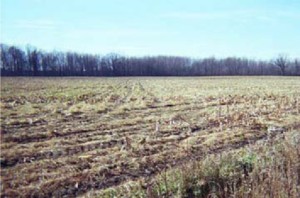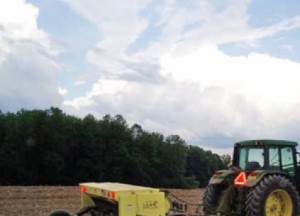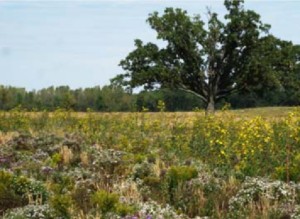Throwback Thursday – A RESTORATION CHALLENGE OF A LIFETIME: THE SENECA MEADOWS PROJECT
This post was initially published in December 2012.
What is your virtual field of dreams for restoration? To put it more concretely, what have you always wanted in a restoration project?
• A client committed to going the extra mile and then some. Check.
• A really large canvas to work on—supporting substantial diversity. Check.
• Opportunity to start from scratch to design and build. Check.
• A chance to monitor the restoration for a significant length of time. Check.
• The use of the area by the public, students, educators, and researchers. Check.
• Protection and management of the area in perpetuity. Check.
• A location near other significant wildlife areas providing habitat connectivity. Check.
In other words, the restoration challenge of a lifetime—potentially with rewards to match.
Well, every once in a while in restoration work, all the stars align and dreams come true. The result is good for the natural world, good for business, and good for people. Such is the story of Seneca Meadows Wetland Preserve in northwestern New York.
In 2004 operators of the Seneca Meadows Landfill sought permits for a major expansion of this landfill, which is the largest landfill in New York. Expansion of the landfill was selected as the preferred alternative over options such as developing a new greenfield landfill. However, the expansion involved projected environmental impacts to 0.3 km2 of wetlands that also encompassed 0.1 km2 of hardwood swamp.
Applied Ecological Services (AES) of Brodhead, Wisconsin was initially hired only to identify sites for the required mitigation as part of the landfill expansion. They began the process, as they usually do, with a natural resources inventory of the landfill property. In doing so, they discovered ways to reduce impacts to the degraded forested wetlands as well as ample opportunities for the restoration of 5.0 km2 adjacent land consisting of 1.4 km2 of wetlands and 2.4 km2 of drained agricultural fields.
In a precedent-setting move, Seneca Meadows committed to the major restoration effort proposed by AES. As District Manager Don Gentilcore explained: “We decided to forego the standard 3:1 wetland mitigation ratio and instead dedicated over eight times the required acreage. A large area of high quality wetland will benefit the local ecology far more than one with limited acreage.” Andy Buss, contracting project superintendent with AES described the project as being “so large in scale that it allowed us to create everything we could dream of.”
The Vision
To begin the project, AES developed hydrological and ecological restoration plans. They facilitated applications for Clean Water Act Section 404 from the U.S. Army Corps of Engineers and for Chapter 24 Freshwater Wetland Act permits from the New York State Department of Conservation. Permits were granted in 2007 and construction began.
The restoration design called for reconfiguring agricultural land to create 0.2 km2 of emergent wetlands, 0.7 km2 of wet prairie, 0.1 km2 of wet mesic prairie, and 0.1 km2 of forested wetlands. The restoration of approximately 0.1 km2 of upland habitat consisting of oak savanna, mesic prairie, and mesic forest were also planned. The incorporation of the upland habitat restoration was intended to result in the development of an integrated wetland-upland ecological landscape, which is an aspect often given short-shrift in wetland mitigation projects.
The scale of the project set a precedent for permitting large impact projects in the state of New York. At a national level, the U.S. Environmental Protection Agency called the project a model of how large-scale mitigation can be used to address large wetland impacts.
The Challenge
It was not only a unique restoration opportunity, it was also one that presented enormous challenges. Collaboration was key. “How on earth am I going to do this?” floated through the minds of the client, AES contractors, consultants, and nursery staff repeatedly throughout the process.
There were other questions and challenges. How can we create an understandable and eminently usable design? What is the academic scientific research that will provide the foundation for the restoration design? Who are our potential long-range partners? How will this area be managed and maintained after construction and after the landfill is closed?
The above are just a sampling of the questions and accompanying angst that occurred well before the construction crew encountered the “surprises” inherent in any restoration project. For example, the discovery of the federally endangered Indiana bat (Myotis sodalist) on site caused immediate modifications in the wetland enhancement protocols and dictated the strategic preservation of all viable roosting trees within the project site.
Through it all, repeating like a leitmotif was the constant updating and coordination from AES with the client, regulatory agencies, non-profit groups, and the public. Think symphony. Looking back, there are those who might even think: “opus.”
The Hard Work
Earthwork involving moving 535,188 cubic meters of soil was necessary to transform flat farm fields into a varied terrain that could support a diversity of wetland and upland native habitats. The plan called for disabling several miles of drain tiles in former agricultural lands as well as blocking and reconfiguring surface drainage swales. In the process deposits of glacial sand were discovered and subsequently left in situ to provide habitat for burrowing animals.
AES installed 169,750 herbaceous plugs, 9,487 trees and shrubs, and selectively removed buckthorn with chainsaws within 1.1 km2.
AES also seeded 1.7 km2 of newly created wetland and upland habitats using 1,361 kilograms of approved native seed materials. Thirty percent of this seed consisted of a customized mixture coming from seed collected locally onsite or within a 8.0 km radius of the project site. The Montezuma National Wildlife Refuge occurred within this 8.0 km radius and served as a local seed source. AES’s Taylor Creek Restoration Nurseries coordinated and conducted seed collections, and processed seed materials from its Brodhead, Wisconsin location.
Strategic enhancement of 0.6 km2 of existing forest and forested wetlands was also part of the planned restoration. Invasive species, such as buckthorn (Rhamnus spp.), were removed through cutting and targeted herbicide application. Early successional native species, such as red maple (Acer rubrum), cottonwood (Populus spp.), ashes (Fraxinus spp.), and cherry (Prunus spp.) trees, were also planted to provide an ecological vanguard to foster colonization of later successional tree species such as oak (Quercus spp.), and hickory (Carya spp.).
And They Have Come
Another noteworthy component of this eight million dollar project is the commitment the owner Seneca Falls provided for long-term monitoring. This has translated to a rare opportunity to assess how aquatic and terrestrial animals responded to the restoration. AES ecologists have initiated long term monitoring of macroinvertebrates, fishes, amphibians, reptiles, mammals, birds and water quality within the restored site.
The first biological inventories were conducted on the old farmland and degraded wetlands before construction. Ecologists found 2 reptile species, 7 amphibian species, and 68 bird species. The birds were generalists typically associated with agricultural lands, such as crows, gulls, geese, and blackbirds. No threatened or endangered species were recorded.
At only one year post-construction (2009) bird species richness had already doubled. Additionally, two bird species (pied-billed grebe and least bittern) considered threatened in New York were found breeding in the site!
Fast forward to 2012 – four years post-construction. The species list has burgeoned to 5 reptile species and 10 amphibian species. Additionally, the majority of the Ambystomatid salamanders captured on the site consist of the blue spotted salamander hybrid (Ambystoma jeffersonianum x A. laterale).
The bird list now stands at 187 bird species, representing over a third of all species recorded for New York. All expected marsh birds have been documented except the king rail. Many New York endangered, threatened, or special concern species are found on the preserve including regionally rare grassland species such as bobolink, the state threatened Henslow’s sparrow, and two species of special concern in New York – the vesper sparrow and grasshopper sparrow.
With Cornell University and State University of New York-Environmental Science and Forestry (SUNY-ESF) each only about an hour’s drive from the site, Seneca Meadows is poised to serve as an important research location. A student from SUNY-ESF has begun a study of native bees and is focusing on the diverse microhabitats within the preserve.
Take a Bow
“An ecological treasure”—that’s what Mickey Flood, chief executive officer of the parent company of Seneca Meadows called the Seneca Meadows Wetland Preserve when the preserve was officially opened to the public in 2010.
In fact, the Seneca Meadows Landfill so thoroughly embraced their restoration wetlands that in 2009 they built the LEED Gold-certified
Blue-spotted hybrid salamander captured at the Seneca Meadows Wetland Preserve Former agricultural fields after planting native plants
Seneca Meadows Education Center adjacent to preserve, with easy access to the 7 miles of foot trails, boardwalks, and wildlife overlook stations. New York Audubon currently staffs the education center and oversees the educational outreach efforts. Audubon has also stepped forward for the role of permanent steward of the preserve and will assume responsibility for managing the preserve after the Seneca Meadows Landfill is no longer in operation.
All this hard work is being recognized. The wetland preserve was honored in 2012 with a “Design by Nature” award presented by the Brownfields Coalition of the Northeast. Seneca Falls Landfill also received the 2012 Gold
Excellence Award for Landfill Management bestowed by the Solid Waste Association of North America in part for its forward-looking approach to its landscape management and commitment to environmental education. Also in 2012, the project received Audubon New York’s Donald G. Colvin Conservation Award recognizing the company’s preservation and advancement of the environment. Seneca Meadows also had a
U.S. Congressional Proclamation bestowed on it in recognition of its commitment to preserve and protect the environment.
The influence of the restored wetland extends even to the arts. “Life of the Wetland,” a mural by regional Connecticut artist Linda Thomas and commissioned for the Seneca Meadows Education Center is featured in a show at the New York Hall of Science running through February 2013. The painting places particular emphasis on the threatened and endangered species that give Seneca Meadows its extra special cachet.
The regional community has enthusiastically embraced the restored natural area, posting pictures and lists of plant and animal species on the Web and eagerly participating in organized tours and other events. It is truly a gift to the Finger Lakes region.
Moving Forward
In 2012, a pair of dickcissels, a grassland bird species more commonly found in Midwestern prairies, showed up at Seneca Meadows Wetland Preserve. This sent the birding hotlines humming and caused some to speculate whether this species might find a breeding refugia from the drought in the East. A Cornell ornithologist was dispatched from nearby Ithaca to document the event in photos and sound recordings. More than a single rare bird event, the dickcissel sighting might be seen as a harbinger of all that a restored wetland complex such as Seneca Meadows Wetlands Preserve can contribute to the ecology of the region—and in this particular case, maybe even the continent.
After all, isn’t making a tangible improvement on earth the underlying dream that motivates the restoration ecologist? Sometimes we actually can see it.
Troy Anderson, Elizabeth R. Tiller, and Michael J. McGraw
Applied Ecological Services




